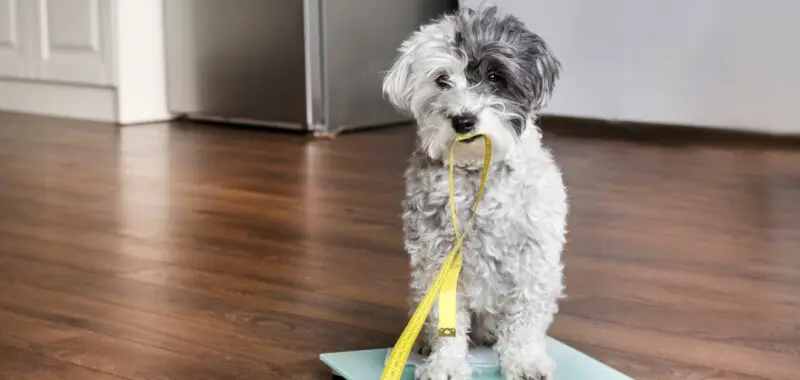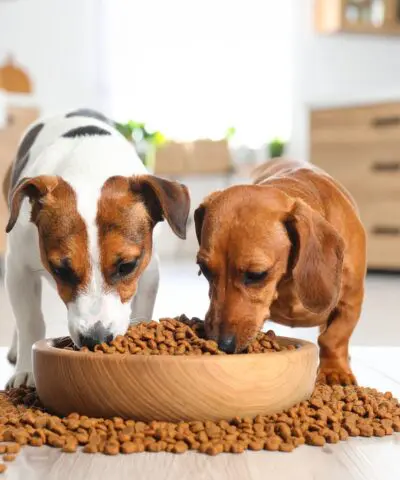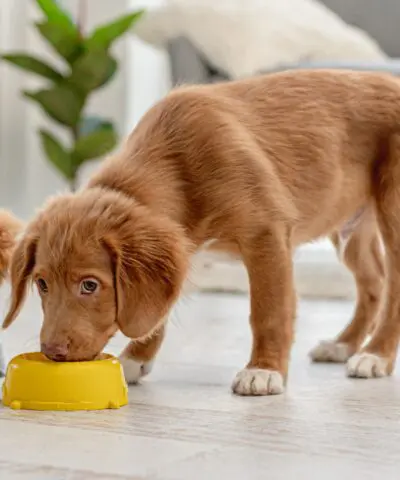Is your dog looking a little larger than usual? While we all love a cuddly companion, your dog being overweight can lead to significant health problems and can prevent them from living a healthy and content life. Like us as owners, the process of losing weight can be tricky, and you may be wondering ‘How do I get my dog to lose weight?’
Luckily for you, this blog post has all the information you need to help your dog shed those extra pounds. At Green Pantry, we create completely natural dry dog food that addresses specific health and dietary requirements, so you can rest assured that your dog is eating only the highest-quality and healthiest ingredients.
Ready to find out how to get your dog to lose weight? Let’s get into it…
How to tell if your dog is overweight
First things first, it’s important to identify and realise that your dog is overweight. Published studies have shown that up to 65% of the UK’s pet dogs are overweight or have obesity, and this is a common problem across the country. Identifying if your dog is overweight can involve a combination of visual assessment and physical examination. Some of the easiest ways to do so is by:
- Checking your dog’s body shape
- Feeling for your dog’s ribs
- Looking at your dog from the side
- Checking your dog for fat pads
- Examining your dog’s behaviour
- Weighing your dog
A dog that has no weight control will generally have no real waistline or distinction between their chest and stomach when viewed from the side. They may also have reduced levels of fitness – you may notice your dog panting when walking, or walking slower than they should need to based on their age and size. Your dog might even turn around to head home mid-walk and sleep more than expected.

Be aware that unexpected weight gain can be a sign of serious illness, so if you think that your dog is randomly overweight, then a trip to the vet is called for.
Tips to help your dog lose weight
Although it can be hard, identifying and accepting that your dog is overweight is the first step to a healthier lifestyle. While the effects of obesity on your dog can be very serious, the good news is that this problem can be easily avoided and reversible. By keeping your dog in shape, you can help them live longer, happier lives!
We recommend staying consistent with the following tips:
1. Plenty of exercise
Just like humans, dogs need plenty of regular activity to maintain a healthy weight. You don’t need to focus on gruelling workouts – think more about enjoyable and enriching experiences that both you and your dog will love. Start simple with daily walks, gradually increasing the distance and pace as your dog’s fitness improves. If your dog enjoys swimming, then add this to their weekly routine. Hydrotherapy is a great way for your dog to become more mobile and also targets dogs who aren’t only overweight but who may be suffering from mobility issues, too.
Playtime is also crucial, and it’s a great way for your pet to enjoy exercise. A good game of fetch, frisbee, or even socialising with other dogs provides a fantastic workout. The main thing is that consistency is key – make exercise a fun, regular part of your dog’s routine, and you should hopefully see those extra pounds melt away and notice that they want to spend more time outdoors running and playing!
2. A healthy and natural diet
Perhaps one of the most important things when it comes to your dog’s weight and well-being in general is their diet. A dog’s weight is significantly influenced by what they eat. Ditch the low-quality dog foods that are laden with artificial additives and fillers and instead replace them with high-quality, whole-food options like our recipes here at Green Pantry.
We recommend giving your dog foods that are rich in lean protein, essential fatty acids, and natural fibres to promote a feeling of fullness and support healthy digestion. Remember, though, that portion control is key. Overfeeding of any dog food, even the healthiest on the market, can contribute to weight gain.
Laura Ward, a pet nutritionist, helps us develop new recipes here at Green Pantry. She says: “The right food is important not only if your dog has a specific veterinary condition or allergy, but to ensure their healthy growth and development throughout their life. A food should match your dog’s life stage, size and lifestyle, as well as their preferences”
Read the full interview with Laura here!
3. Limit treats and table scraps
Giving your dog treats, other than for training, is not essential. Ideally, 10% of a dog’s daily calorie intake can come from treats, and they should be given in portions no bigger than the nail of your finger. These seemingly small additions of food might not seem like a lot, but they can significantly impact your dog’s overall calorie intake. Giving your dog scraps from the table can also reinforce begging behaviour, making it more difficult to control their food intake and creating a cycle of over feeding and weight gain.
If you do want to treat your pooch, make sure it’s with a natural dog treat, and in particular one that has a very low fat content, ideally less than 2%, like Green Pantry’s Whitefish with Parsley and Potato dog treat
4. Monitor their progress
To help you see how well you and your dog are getting on, and whether further improvements can be made, tracking and monitoring their weight loss is crucial. Keep a daily log of their food intake, including treats, and what exercise they partake in. While it might seem like a lot of effort, recording these details can help you to evaluate if your dog’s weight loss programme and change in lifestyle is working.
It might be a good idea to get into the habit of checking your dog’s weight every week or so to monitor any changes. You might even want to take photos of your dog from above and from the side so that you have something to compare. Alternatively, if you can pick your dog up easily, you could weigh them regularly so that you can see if the number is decreasing week on week. It’s very common to lose motivation or hit a wall when your dog might not seem to change weight for a while. Just remember that this is normal and you should continue with everything that you’re doing – these things take time!
Additional weight loss ideas for dogs:
How fast your dog will lose weight will depend not only on how strictly you keep to the tips above, but also on their breed, genetics, and if they’re a growing dog. Some other easy tips to implement include:
- Use puzzle feeders or toys that dispense food slowly, making your dog eat their meals slower and helping with portion control.
- Opt for natural dog supplements – some natural supplements may help with weight loss in dogs, but you should consult your veterinarian before giving them to your dog.
- Ensure you’re measuring the correct food portions and always read the instruction labels on packs of dog food.
How long will it take to notice changes?
Remember, the transformation of your overweight dog won’t just happen overnight. It’s about being consistent and patient. It can take as little as a few months in some cases, while others may take up to a year. Some dogs may be able to lose weight quickly, while others may need to take things a little slower – for example, it can be harder for senior dogs to lose weight because of their slower metabolism, reduced activity, and muscle loss.
Regardless of the time it takes, the key to weight loss is dedication and commitment.
Help your dog lose weight safely with a Green Pantry diet
Hopefully, this blog post has answered your question ‘How can I help my dog lose weight?’ As with any health-related issue, prevention is the best cure. The sooner you impose a regular, well-portioned diet and regular exercise on your dog, the better chance they have at staying healthy and living a well-fulfilled life! Admit to the reality of an overweight dog and take charge of your dog’s diet to get them back into shape.
At Green Pantry, your dog’s health is at the forefront of what we do. If you require any more information, please don’t hesitate to get in touch. Customer satisfaction is one of our main priorities, so a member of our team will be more than happy to get back to you. Alternatively, you can speak to us over the phone by ringing us on 01553 811 320.
“I’ve been using the White Fish product to help my terrier (who is very greedy) control her weight. The low-fat nature of this product has been perfect and she’s never looked more healthy. 5-star product and 5-star service!”
Read more of our excellent 4.9/5 Trustpilot reviews here!
Dog weight loss FAQs:
What is the best dog food for weight loss?
When choosing the best dog food for weight loss, it’s essential to prioritise a balanced and nutritional ingredient profile that supports healthy weight reduction. Consider foods that include high protein and fibre, and low fat, as well as plenty of fruit and vegetables. Here at Green Pantry, you can get your paws on sample packs of our dog food. Learn all about what’s in the pantry and decide on the best weight loss dog food for your pooch!
How to put your dog on a diet for weight loss?
Putting your dog on a diet for weight loss will require a structured and consistent approach. We recommend following the tips given in this guide, as well as consulting your veterinarian to create a diet plan and exercise routine that is right for your dog. Remember to always prioritise your dog’s health and well-being and to stay patient throughout the weight loss process.
How much should I feed my dog for weight loss?
When it comes to feeding your dog dry dog food, how much you should be feeding them depends on their size, weight, and age. If your dog is overweight, this should be decreased. Ideally, a dog should lose about three to five % of their body weight each month – for example, a 30kg dog should lose about 0.35kg a week or 1.5kg a month. Our dog food packaging has the recommended feeding guidelines, but remember that these are based on your dog maintaining weight, not losing it.





